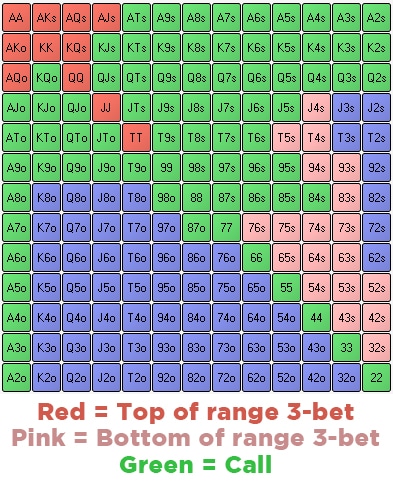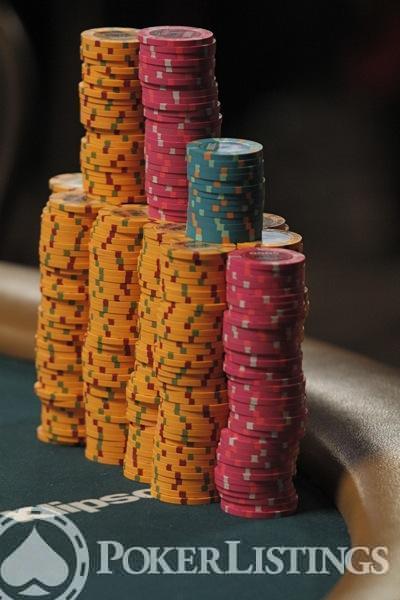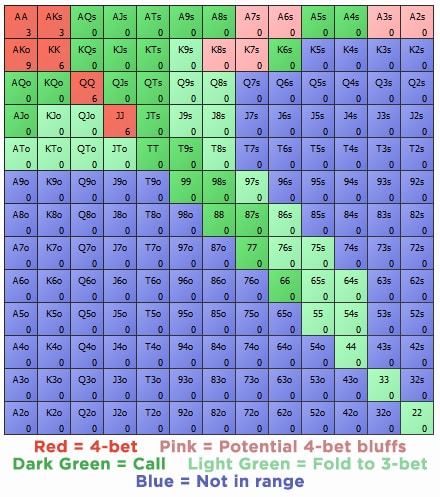Poker 3 Bet Bluff Range
Very few things are more fun in poker than light 3betting. Re-raising someone while holding nothing but total junk can make your play more enjoyable, but also more profitable if you pick your spots correctly. One way to make these bluff re-raises even more profitable is to 3-bet with blockers. I constantly use blockers when bluffing preflop. Live Poker 131 Threads. 3 bet ranges Bluff:value ratios. Funny thing happens when we I ended up constructing BUTTON vs CO range. If I 3 bet 4% vs EP, 8% vs MP.
The main objective of 3 Bet Bluffing in Texas Hold'em is to take down the pot pre-flop. Many players don’t recognise what hands they should 3 Bet for value and what should 3 Bet to to bluff. Some players are simply ‘clicking buttons’ and do not have a solid preconceived plan to follow.
If you only three-bet a tight range – say AA-QQ and A-K – your opponents know that when you three-bet you can only have one of four hands. Obviously, that’s not a balanced range. When your re-raising range is so narrow your opponents can always make the right decisions. In this scenario, we raise from UTG and get 3-bet by the small blind. At this point, we can already assign them a pretty strong range – players don’t often bluff from the small blind, as it is probably the worst position to do it from, especially against an early position raise. In this range, you would be 3-betting QQ, AKo, AK, AKs and AA for value, planning to 5-bet all in against a 4-bet. You would be 3-betting A2s–A5s as a bluff, and planning on folding to a 4-bet. In this situation, you have 16 combos of hands that are bluffs, and 34 that are value, which is a good range for beginners to become more comfortable.
Benefits of 3 Bet Bluffing are:
1) Boosting our Win Rate
2) Creating an Aggresive Image
3) It's low variance due to the fact we don’t have to c-bet and play postflop when our opponents fold.
Who should be target for the 3 Bet Bluff?
1) an opponent who folds to 3bets often. stats wise f3b 70%+
2) an opponent who attempts to steal often(Button opening of 40%+)
What position to 3 Bet Bluff in?
Hands to 3 Bet Bluff with
1) Bet the top of your range with hands that are not strong enough to call with. Hands such as AxS, KxS, suited 1 gappers (97s, 68s), suited 2 gappers (710s), Small pocket pairs (if you can’t set mine profitably).
Hands not to do it with

2) We shouldn't use this play with hands we can dominate our opponents range with. KQos for example. If they fold to the 3bet then we miss out on potential post flop value.
Positional Awareness:
1) Our 3bet will be interpreted as stronger or weaker depending on the positions involved.
2) Blind vs. Blind battles. We may get played back at more from these positions.
3) 3bets look much stronger MP vs EP than BB vs BTN
I am ready to take my poker game to the next level!
Pay attention of:
Who we are 3betting - For example If a fish folds to 3bets a lot from CO but not EP then we should not be bluffing vs his EP open a lot. However vs a reg we can do it as we get more credit for our 3bets.

Bet Sizing for 3 Bet Bluffs:
Should be somewhere between 2.8x and 3.5x the original raise. This will allow us to get most respect but to lose the least if 4Bet.
Squeeze sizing from blinds should be around 12bbs vs 2 players.
How often does our 3bet bluff need to work?

SB raises to 3bb, hero BTN raises 9bb, Risking 8bb more to win the 4bb pot. Total pot = 12bb. Hero invests 8bb/12bb which is 66.66% so we need to win the pot this amount of the time to break even in the long run. Anything above this is profit. If the villain has a f3b 67%+ then heros play is +EV in the long run.
Final Pointers:
1) Don’t go crazy - Players will play back at us.
2) Our play works more if we have a tight table image.
3) Don’t do it all the time until it stops working. Be smart and constantly adjust to your opponent.
We have all heard about 3-betting bigger out of position and smaller in position, but there are two factors in the theory of 3-betting which affect how big we should go. Position is one of them and range shape is the other. Let’s focus on this less discussed factor today. How does the sort of range we’ll be 3-betting affect the sizing we should choose? And how do we determine the shape of our 3-bet range in the first place?
Range Shape
A 3-Bet range might be linear or it might be polarised. What’s the difference?
Linear Ranges
3-Betting with a linear range means 3-betting AA and then all of the hands weaker than AA down to a certain hand which is deemed too weak to 3-Bet. It might look like [88+, all suited broadways, all suited aces, AJo+, KQo+, T9s, 98s] or in another spot it might be tighter and exclude the weaker hands in that range. Linear essentially means ‘no gaps’. When we’re 3-betting linear, we will never favour a weaker hand over a stronger one.
We 3-bet with a linear range under two circumstances:
- When we are not building a calling range against the open. In this case we are entering the pot with a 3-Bet or not at all. It would not make sense to choose to play a hand that is weaker than one we are folding, so we 3-bet from the top down.
- When Villain or population does not fold much to 3-bets. In this case we want to only increase the size of the pot for value and not for fold equity. 3-Bet bluffing is not advisable and so we 3-bet all and only those hands deemed good enough to be value 3-bets.
Polarised Ranges

A polarised 3-Bet range is one that has a value component and a bluff component. These two groups of hands are separated by a calling range. Therefore, when we 3-bet polarised, we must have a calling range to serve as a buffer between value hands and bluffs. A polarised range might look like: [JJ+ AQs+ AKo, A2s-A5s T9s 98s 87s] in the most extreme example. If our range is purely polarised, then it means we are flatting the hands in between these two groups and folding all hands weaker than our 3-bet bluffs.
One more modern option is to play a mixed polarised range. This still entails having a chunk of very strong hands that you always 3-bet for value. The difference with this range is that some of the weaker hands get mixed between 3-betting and calling. This has the advantage of increasing the calibre of the bluffs, but the disadvantage of playing less hands overall. We only have a finite amount of space for bluffing in our strategy before it becomes too bluff heavy and exploitable. This might be okay against weaker players who fold too much, but is a concern against stronger opposition. So when we 3-bet A5s as a bluff, we have less room for K3s.
Poker 3 Bet Bluff Ranger
We opt for a polarised range when:
- We want to have a calling range
AND
- We think Villain or population folds a decent amount of the time to 3-Bets.
The higher EV we think it is to call our medium strength hands, the less likely we are to turn them into 3-bet bluffs. When we are in position, then, BB vs a SB raise, we are very unlikely to 3-bet bluff any medium hands. A5s and the like will often just call because they are so profitable to flat and hate to get 4-bet off of their equity. Meanwhile, a hand like J4s which is around break even to flat is perfectly reasonable as a 3-bet bluff as we are not squandering much calling EV by 3-betting it instead.
Contrast this to a spot like BB vs UTG, where A5s is not a massively profitable call. In this spot we would mix the hand between 3-bet and call as both options are roughly equal in expectation and never dream of 3-betting Q4s. Thus, we are using a mixed polarised range BB vs UTG but a purely polarised range BB vs SB.
Linear Ranges want to Use Smaller Sizing
Generally speaking, big value hands increase their EV when they put more money into the pot. Medium strength hands, often called ‘tier 2 hands’, increase their EV by using a smaller sizing. The reason for this is that they do not want to filter out too many of the weaker hands in Villain’s continuing range to the 3-bet because these are the hands they dominate and perform well against. TT does not want to 3-Bet huge HJ vs UTG as there are still four uncapped ranges behind and TT will perform badly if it filters the UTG player too much.
Remember that Linear ranges are full of medium strength hands, and so they want to use a smaller size. I would 3-bet from 2.5BB to 7BB in position HJ vs UTG and from 2.5BB to 11BB out of position.
Polarised Ranges want to Use a Big Sizing
Remember, the big hands like AA, KK, QQ, and AK prefer to use a large size. The more money you can shovel into the pot with these hands, the better (unless stacks are short and building a big pot is unnecessary.) Since nutted hands are a significant part of a polarised range, polar ranges like betting bigger.

Poker 3 Bet Bluff Rangers
Bluffs rely on pre-flop fold equity to be profitable or break even, so when your range contains a sizable portion of very weak hands, you want to increase fold equity. Making a small 3-bet that would usually get called is not a good idea when you’re holding Q3s.
Since polarised ranges contain less medium strength hands, which prefer playing smaller pots against wider ranges, they have no reason to shy away from big sizing and every reason to utilise it.
If I were 3-betting a polarised range in position, I would tend to go from 2.5BB to 9.5BB. Out of position I would go from 2.5BB to 12BB.
Summary
- Linear ranges 3-bet from the top down without a gap. We use them either when we’re not calling anything or when fold equity is low. They want to use a smaller sizing because they contain a lot of medium strength hands that strive to keep pots smaller.
- Polarised ranges 3-bet two distinct groups of hands: value hands which are very strong and like to build big pots and bluffs which seek fold equity. We choose a polar range when we have both a calling range and reasonable fold equity. Since polar ranges contain hands that like putting more money into the pot, and no medium strength hands, they like a big sizing.
Join us on our Discord channel.